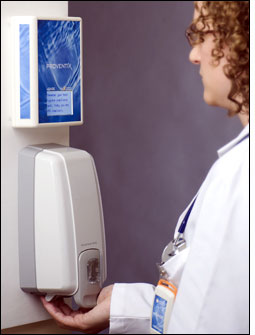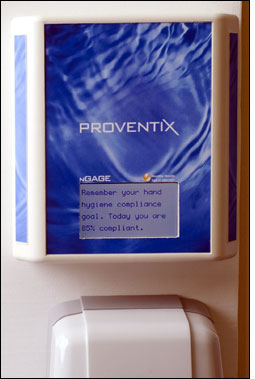Princeton Baptist Medical Center, in Birmingham, Al., reports that it has seen a 36 percent reduction in patient visit time resulting from a health-care acquired infection (HCAI) since it began employing an RFID-based hand-washing compliance system in February 2010. That equates to 125 fewer bed days since February in which patients were hospitalized for infections gained while receiving treatment at the facility. The system, known as nGage, was provided by Proventix, with Synapse Technologies providing and installing customized readers and tags that operate at 2.4 GHz and utilize the IEEE 802.15.4 (ZigBee) specification.
According to the World Health Organization (WHO), between 5 and 15 percent of people in developed nations who are admitted to a hospital end up with an HCAI, and end up requiring treatment for the infection they acquired during their stay. That statistic was part of the inspiration behind Proventix’s hand-hygiene solution, intended to increase hand-washing compliance for health-care staff members without otherwise disrupting their normal hospital activities. The company began developing the system three years ago. In December 2009, its CEO, Harvey Nix, was coaching a football game after a local newspaper had covered the firm and its mission, and a player’s parent—an anesthesiologist at Princeton Baptist—approached him to learn more about the technology. Soon, Nix and the hospital’s management began developing a plan to launch the hand-hygiene solution on one floor of the facility.
“This was almost a no-brainer,” says Paula Davenport, Princeton Baptist Medical Center’s director of surgical services. “As we all know, hand washing is one of the primary ways to prevent the spread of infections.” Since the system was installed, she notes, “We definitely have seen an improvement in infection rates.”
During the past few years, other hand-hygiene systems using RFID have been developed and commercially introduced (see RFID Debuts as Hand-Washing Compliance Officer and Patient-Safety Center Tests RFID-enabled Hand Sanitizers). Some issue alerts by pager or phone, and some produce an audible announcement to notify a health-care worker who has failed to wash his or her hands. Princeton Baptist wanted a system, however, that would be easy and enjoyable to use, rather than something that would have a punitive effect on its staff (such as embarrassing them with audible alerts). Although the Proventix system can send alerts to pagers or phones, Davenport says, the hospital wanted only to encourage workers to wash their hands, not issue an alert when they failed to do so.
The Proventix system that the hospital has installed enables a user to view messages displayed on a screen mounted above the soap or alcohol dispenser at each hand-washing station, which also contains an RFID reader. Although the medical center is initially displaying only generic information regarding the value of hand washing and its impact on diseases such as the flu, in the future, Proventix software will cause the screen to display personalized information for the dispenser user, as well as providing health-care information about the patient who may be in the room in which that dispenser is located. (For example: “Alert: Patient is a fall risk.”) If a user is a physician with an interest in updates specific to certain medical regulations, for instance, that is what he or she will see on the display. What’s more, CNN headlines or sports results could be provided as well, if so requested. (“Lakers beat Suns 122-108 in 2 OT to clinch Pacific division.”) In addition, if the employee is visiting a patient in that person’s room, he or she can see details about the patient’s lab results or other medical details while washing his or her hands, that can help to determine which health-care services to provide.
Proventix installed an RFID-enabled hand-washing station in each room on the hospital’s post-operative surgical floor, where there are 42 patient beds, as well as stations throughout the floor’s hallways, for a total of about 80 stations. Each staff member wears a 3.5-inch-long plastic badge containing an active RFID tag encoded with a unique ID number linked to that individual’s name, position and other details in the Proventix standalone software system. The readers create a mesh network allowing the RFID tag to be read and located throughout the floor in which the system is installed. When a tag transmits a signal encoded with its ID number, Nix explains, a reader receives that signal and forwards the tag’s ID number, along with its own ID, to a bridge connected to the back-end system via an Ethernet cable to a PC. There are currently three bridges installed on the floor, he says.

When a physician enters a particular patient’s room, the system determines that the doctor has entered that specific room, based on the dispenser’s reader ID number. Upon approaching the hand-washing station, he or she must press the dispenser lever to use the sanitizer or soap and water. At the same time, the software links the ID number of the individual standing in front of the station with the dispenser’s activation. The software then displays messages specific to that user (currently, all Princeton Baptist employees receive the same message, describing the importance of hand washing on reducing infections, and providing statistics to reinforce that message), and also stores a record of the event, indicating when and where the employee has washed his or her hands.
When the staff member leaves the patient’s room, the system expects another hand-washing event from that dispenser to occur. If the doctor does, in fact, use the dispenser a second time, that event is recorded. If not, however, the system creates a record noting that, though that information is not used to penalize the employee, Davenport notes. “We wanted to focus on incentives,” she says, and in this case, the incentive for health-care workers is to develop a track record showing they washed their hands regularly. Data can also be displayed on the screen indicating the number of times that individual has washed his or her hands, as well as how he or she compares with other workers. (“Remember your hand-hygiene compliance goal. Today, you are 85% compliant.”) “By nature, people in the medical profession are very competitive,” Davenport states. To date, she says, she has found that the staff use the stations to try to build a high record of hand washing.
Hundreds of employees are wearing the badges, Davenport reports, in addition to their existing ID badges, which do not contain RFID tags and are merely printed with the staff member’s name. In the future, she says she hopes that each worker will have an ID badge that incorporates the Proventix RFID tag. During the next six weeks, the hospital intends to install the system in its intensive care unit, and after six months, it will consider expanding the deployment throughout its entire facility.
With the RFID infrastructure in place, Davenport says she hopes to eventually utilize the system to also track the location of assets, by attaching similar RFID tags to equipment. Proventix does not offer a specific application for tracking assets in the health-care environment, Nix notes—but for Princeton Baptist, he says, the company can build asset tracking onto the existing system. “We can expand to a more robust RFID solution in the future,” he states.


